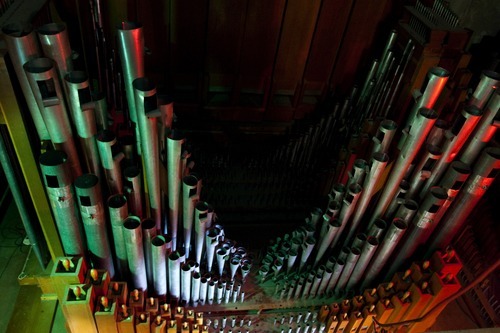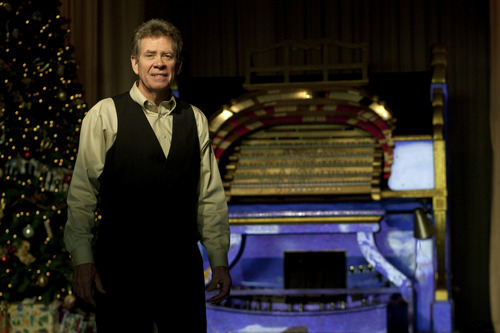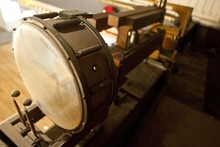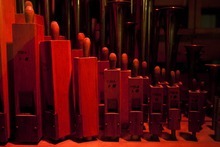This is an archived article that was published on sltrib.com in 2012, and information in the article may be outdated. It is provided only for personal research purposes and may not be reprinted.
This movie season — thanks to "The Artist" and "Hugo" — the Organ Loft, Utah's only theater house hosting silent film screenings to live music accompaniment, has seen its attendance rise.
"Another couple we'd never seen before came in two weeks ago saying they'd seen 'The Artist,' " said Blaine Gale, the Organ Loft's 78-year-old house organist. "They said they came here because they want to see the real thing."
Gale and E. Hunter Hale, a film buff and Organ Loft programmer, are happy to return the favor. They beseech patrons to see "The Artist" or "Hugo," preferably both, as soon as possible.
Both movies are Best Picture contenders in the 84th Academy Awards ceremonies. In their plots and cinematography, both celebrate the so-called Golden Age of silent film. Or as Hale summarizes Hollywood's tendency toward nostalgia: "It's human nature to root for the home team."
The synergy these films have created for the Organ Loft shines a light on Utah's history of silent-film theater houses. Four "Mighty Wurlitzer" organs dot Northern Utah, from Salt Lake City to Ogden and Logan, remnants of a time when most films were viewed without voices to move the story forward, relying instead on rows of keys and ranks of pipes.
—
Cinematic debts to the past • "The Artist," a creation of French director Michel Hazanavicius, follows the inverse fortunes of silent-film actor George Valentin, played by Jean Dujardin, as he struggles to enter the era of "talkies," while his onetime apprentice Peppy Miller, played by Bérénice Bejo, rockets to stardom through speaking parts. Their interactions along the way spark a romance that, by film's end, catches full fire. A silent, black-and-white film that only flirts with sound in key moments, it's shot to replicate the exact feel of a silent film, circa 1927.
"Hugo," by contrast, was adapted from the best-selling children's book by Brian Selznick and directed by Martin Scorsese. The book and film offer narrative and visual homages to the beginnings of film, with an emphasis on the works of George Méliès, the French director whose 1902 film "A Trip to the Moon" lies at the center of a boy's attempts to reconnect with his dead father amid a hardscrabble life in a Paris train station.
Implicit in both is the message that early films haven't lost the power to turn audiences into dreamers. The young Hugo finds refuge in the imaginative world of film and story. In "The Artist," Valentin and Miller mock each other's respective preference for silent and "talkie" films until realizing that both genres work together. There's no future without debts to the past, yet the past is unique because of the works that follow.
—
Utah's Wurlitzers • It's estimated that the Wurlitzer Company, first of Cincinnati and then Chicago, manufactured more than 2,200 of these theater organs between 1914 and 1942. Due to their massive size, and keys activating scores of instruments such as drum cymbals and horns requiring rows of shelf space, some of the most revered Wurlitzers reside where originally installed, such as the organ at Denver Paramount Theatre.
The closest Salt Lake City can boast is the Wurlitzer at downtown's Capitol Theatre. Installed in 1927, it was used for only a handful of years as the "talkies" ascended in the early 1930s.
In 2009, due to space considerations, the organ was moved from the basement for display in the theater's mezzanine lobby area. It was used most recently between 2005 and 2007 for revival screenings of silent films hosted by KUER. It boasts two keyboards and 11 ranks, or full group of pipes that each vary in the number of notes.
"It needs maintenance," said Melinda Cavallaro, events director for Salt Lake County, which manages the Capitol Theatre and its amenities. "But it's a wonderful piece of theater history."
Ogden's Peery's Egyptian Theatre houses a Wurlitzer with three keyboards and 23 ranks. Another Wurlitzer organ, owned by singer Michael Ballam, professor of music at Utah State University and director of Utah Festival Opera and Musical Theatre, holds three keyboards and 16 ranks. It will be installed at Logan's Utah Theatre after renovations are finished.
—
When the dragon inhales • As fine as those instruments are, they can't compete for range with the Organ Loft's Wurlitzer, a bounty of five keyboards of and a veritable sound army of 36 ranks.
If you've ever seen a movie to live Wurlitzer accompaniment, you know that's a lot of music. The "Mighty Wurlitzer" is renowned for not just its capacity, but its immediacy, intimacy and ability to replicate the sounds of an orchestra.
The Organ Loft's instrument came from the Paramount Theatre in Scranton, N.Y., renovated and expanded with parts from organs at Salt Lake City's Utah Theatre on Main Street and Ogden's Egyptian Theatre. The organ was installed at the Loft's 3331 S. Edison St. address in 1947, when a chicken coop abutted the property. For years, the venue hosted weddings, dances and assorted concerts, before it began screening silent movies in 1984. After years of having the cinematic neighborhood to itself, in 1998 a palace of "talkie" films in the form of the Century 16 Salt Lake theater opened across the street.
On a recent weekday morning, just before Gale ensconces himself on the organ's bench to play, he delights in throwing the switch that pumps air through the manifold pipes of the Organ Loft's instrument. "The dragon is about to inhale!" he warns.
The pipes hoot, sing, groan and rumble like distant thunder amid sound effects of a car horn and cymbals that tickle and crash.
After decades of perfecting his skill and art, Gale says he's still amazed to hear how a chord of notes takes on different meanings depending on the film image on screen that he's accompanying. Similar to the improvisations of a jazz musician, the theater organist responds at key moments to both the film and audience reactions. One person's laugh can be a spark that lights the fuse, and everyone explodes.
"It's through that experience that I've begun to understand the word 'epiphany,' " Gale said. "If I disappear completely into the foreground as the audience enjoys the film, I know I've done my job."
Twitter: @Artsalt
Facebook.com/nowsaltlake —
Upcoming silent films at The Organ Loft
William S. Hart in "Sand," March 8 and 9; Buster Keaton's "The General," March 22 and 23; F.W. Murnau's "City Girl," April 5 and 6.
Where • The Organ Loft, 3331 Edison St., South Salt Lake (just east of State Street at 3300 South)
Info • Call 801-485-9265 or visit http://www.organloftslc.com. Note: Screenings are subject to change, so you're advised to call for schedule updates.
Tickets • Generally $6 adults; $5 for children —
A beginner's guide to silent films
1915 • "The Birth of a Nation," by D.W. Griffith. Blatant racism and offensive pro-Confederacy message aside, it's still requisite viewing for film-studies majors given Griffith's first-on-the block directing touches. Otherwise, the N.A.A.C.P. protested this film's content, and for good reason.
1920 • "The Cabinet of Dr. Caligari," by Robert Wiene. Art majors go agog over its German Expressionist overtones, but you can watch it as one of the finest horror films of all time, silent or not. Something is afoot in the small village of Holstenwall, with Dr. Caligari and his sleepwalking Cesare as prime suspects. It's so engrossing that the surprise ending never fails to surprise.
1924 • "The Navigator," by Buster Keaton. Everyone knows and loves his later work "The General," but it was in this film, about a honeymoon sea cruise gone horribly and hilariously wrong, that the great silent film director really cut his teeth on stunt-scene derring-do. Scenes involving black island natives will make the politically sensitive wince, but scenes of Keaton in deep-sea diving gear are without peer.
1925 • "Battleship Potemkin," by Sergei Eisenstein. Yes, it's Soviet Russian propaganda, but the end of the Cold War means we can once again enjoy, for starters, the vast canvas of film montages of battleship mutiny and civilian massacres. The famous "Odessa Steps" sequence is a lasting metaphor for outsize film ambition. Keep an eye out for the baby carriage.
1927 • "Metropolis," by Fritz Lang. If not the first sci-fi film, certainly one of the finest in the genre. The robot inspired C-3PO from "Star Wars" and, most likely, the automaton from last year's "Hugo." Everyone can relate to the dystopian plot, with its underground workers struggling to keep up with the boss's orders.
1927 • "Sunrise: A Song of Two Humans," by F.W. Murnau. Yes, the German director's "Nosferatu" remains an exemplary horror movie. And Roger Ebert counts "The Last Laugh" as a silent fave. Yet it's this warm-hearted film about spousal romance on the rocks that endures. The only film to watch after you've had a fight with your partner.
1928 • "The Passion of Joan of Arc," by Carl Theodor Dreyer. Legend has it that Renée Jeanne Falconetti was so physically and emotionally drained after acting the title role of French saint and national martyr that she never acted again. Watch it yourself to understand why. The discovery of Dreyer's master negative of the complete film in an Oslo hospital is the stuff of legend. So is this riveting film.
1929 • "Pandora's Box," by G.W. Pabst. The ultimate femme fatale film, and Louise Brooks' most sultry calling card as the party girl who destroys everyone in her path, until falling into the hands of Jack the Ripper. Gritty and alluring, Pabst was one of the first silent directors to get down in the gutter to reveal hard truths about human nature.
1930 • "Earth," by Alexander Dovzhenko. The cinematic poet to Eisenstein's epic novelist, Dovzhenko's film about a tractor's impact on a Ukrainian farm community may not sound like much, but no one captured the simple sight of a pear tree or funeral procession with such vibrant grace and flat-out vision.
1930 • "L'Age d'Or (The Golden Age)," by Luis Buñuel. It's either this or "Un Chien Andalou," the 1929 film everyone remembers for its sliced-eyeball scene. Don't watch either for plot. Just revel in the surreal tone of cascading imagery. You might come away with a better understanding of paintings by Salvador Dalí, a close friend of Buñuel and frequent collaborator.
1931 • "City Lights," by Charlie Chaplin. Never mind that "talking films" are already a fact of life since 1928. Many regard this as Chaplin's masterwork. It's certainly his most effective tearjerker, with the Tramp's famous scenes and ultimate final encounter with a blind flower girl. Defined the phrase "feel-good movie."



















